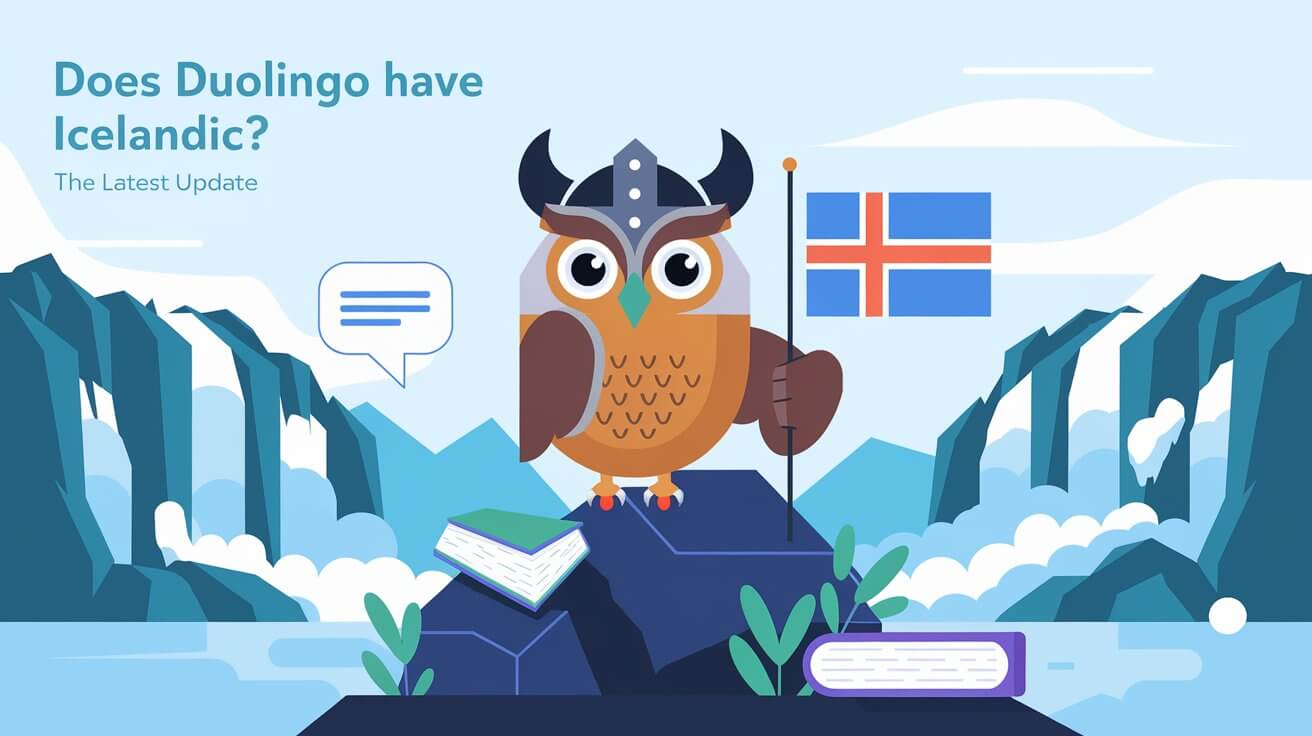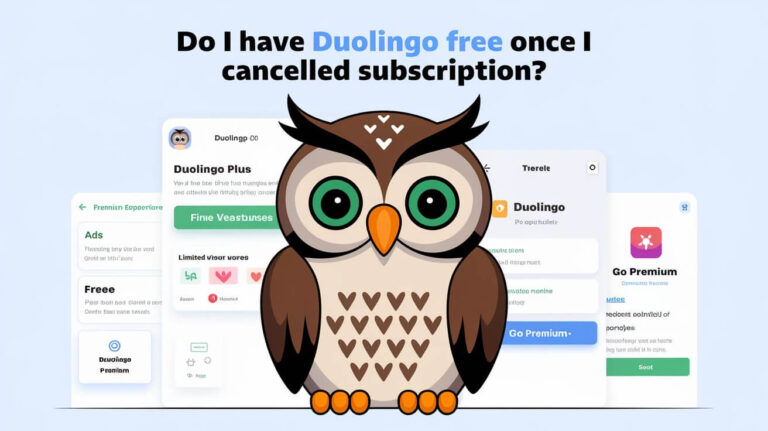Many people wonder if Duolingo has an Icelandic course. With over 350,000 speakers, Icelandic is a fascinating language. It’s perfect for those who love learning new languages and diving into different cultures.
Unfortunately, Duolingo doesn’t have an Icelandic course yet. This might surprise you, given Iceland’s popularity and the growing interest in Icelandic. But don’t worry, there are other ways to learn Icelandic.
Platforms like Pimsleur and Clozemaster offer Icelandic courses. They help learners improve their skills in this complex language. So, even without Duolingo’s Icelandic course, you can start learning Icelandic today.
Current Status of Icelandic on Duolingo
Right now, Duolingo doesn’t have an Icelandic language course. But, it does offer courses in Danish, Norwegian, and Swedish. This shows Duolingo focuses on languages with more users. Yet, people keep asking for Icelandic, and there are other places to learn it.
More than 350,000 people speak Icelandic, mostly in Iceland. Sites like Memrise, Pimsleur, and Drops have Icelandic courses. This shows more people want to learn Icelandic.
Official Platform Position
Duolingo says Icelandic courses are not available yet. They choose to focus on languages with more users. But, they might add Icelandic in the future.
Community Requests Status
People keep asking for Icelandic courses on Duolingo. They really want to learn Icelandic. Even though Duolingo hasn’t said yes, other sites offer Icelandic courses.
Development Timeline Updates
Duolingo hasn’t given a timeline for Icelandic courses. They focus on languages with more users. But, they might add Icelandic if more people show interest.
Some popular places to learn Icelandic include:
- Memrise
- Pimsleur
- Drops
These sites have many courses and resources for Icelandic. They help language learners meet their goals.
Similar Languages Available on Duolingo
Looking to learn Icelandic? Duolingo has courses in Danish, Norwegian, and Swedish too. These languages have similar grammar and words, making them a good start. Learning these can help you understand the language family better and improve your skills.
Learning similar languages on Duolingo has many benefits. Here are a few:
- Improved understanding of grammar and vocabulary
- Enhanced language learning skills
- Access to a wide range of courses and resources
Duolingo’s courses in similar languages build a strong language learning foundation. This is great for those wanting to learn Icelandic. Duolingo’s interactive platform makes learning fun and effective. It’s a great tool for anyone looking to improve their language skills.
| Language | Similarities to Icelandic | Duolingo Course Availability |
|---|---|---|
| Danish | Similar grammar and vocabulary | Available |
| Norwegian | Shared language family and vocabulary | Available |
| Swedish | Similar pronunciation and grammar | Available |
Popular Alternatives for Icelandic Study
There are many ways to study Icelandic, not just in classrooms. With mobile apps, online courses, and traditional learning, you can choose what works best for you. Icelandic study fits different learning styles and preferences.
Apps like Pimsleur and Clozemaster offer interactive lessons. They help improve speaking and listening skills. These apps are great because you can learn whenever you want. Online courses give a more detailed approach to learning Icelandic. They have lessons for all skill levels.
Mobile Apps for Icelandic
Some top apps for learning Icelandic are:
- Pimsleur: Focuses on pronunciation and conversation skills through audio lessons.
- Clozemaster: Uses games and exercises to boost vocabulary and grammar.
- Memrise: Helps you remember new words and phrases with spaced repetition.
Online Courses
Online courses are also a good choice for Icelandic study. Some notable ones are:
- Icelandic Online: A free course by the University of Iceland for beginners and intermediate learners.
- Transparent Language: Offers a subscription-based course with detailed lessons and exercises.
For a more personal touch, consider language exchange programs or tutoring. There are many options for Icelandic study and language learning. You can pick the one that fits your needs and goals.
| Alternative | Description |
|---|---|
| Pimsleur | Audio-based lessons for pronunciation and conversation skills |
| Clozemaster | Interactive exercises and games for vocabulary and grammar |
| Memrise | Spaced repetition for memorizing new words and phrases |
Does Duolingo Have Icelandic in Development?
Right now, there’s no news on an Icelandic course for Duolingo. The company hasn’t said they’re working on it. It might take two years for a beta version if they decide to start.
There aren’t enough native speakers to help make an Icelandic course. This is why it’s not available yet.
Even without an Icelandic course on Duolingo, there are other ways to learn. Memrise, Pimsleur, and Drops are good options. They offer many courses to help you learn Icelandic.
Here are some key facts about Icelandic language learning resources:
- Icelandic is considered one of the hardest languages for English speakers to learn.
- The demand for Icelandic language learning resources has been growing due to an increase in expats moving to Iceland.
- Icelandic is rated as a “hard” language for English speakers according to the Foreign Service Institute (FSI), which assigns it a Category III ranking.
Even though Duolingo doesn’t have an Icelandic course, it has over 100 courses in 40+ languages. This includes Spanish, French, and German. Duolingo has worked with over 500 million users and has more than 56.5 million users learning languages.
| Language | Course Availability | Difficulty Level |
|---|---|---|
| Icelandic | Not available on Duolingo | Category III (hard) |
| Spanish | Available on Duolingo | Category I (easy) |
| French | Available on Duolingo | Category I (easy) |
Language learners can keep an eye on Duolingo for updates on Icelandic. Until then, they can use other resources to learn Icelandic.
Free Resources for Icelandic Language Learning
There are many free resources for learning Icelandic. Audio materials like podcasts and lessons help with listening and speaking. Text resources, including blogs and forums, offer lots of info on grammar and vocabulary.
Some top free resources include Icelandic Online and Mimir. They offer detailed courses and materials. Practice communities, like language exchange programs, let learners practice with native speakers.
Audio Materials
Audio materials are great for improving listening and speaking. You can find podcasts from RÚV, the Icelandic National Broadcasting Service, and YouTube channels like “Icelandic Lessons” and “Polyglot Pablo”. These offer free audio for all levels.
Text Resources
Text resources are key for learning Icelandic. The University of Iceland has a free online course on basic grammar and vocabulary. There are also free textbooks and PDFs for beginners, like “Learning Icelandic” and “Íslenska fyrir alla”.
Practice Communities
Practice communities are perfect for practicing with native speakers. Sites like Tandem and ConversationExchange.com connect you with Icelandic speakers. Reddit communities, like r/Icelandic and r/languagelearning, also offer support and resources.
| Resource | Description |
|---|---|
| Icelandic Online | Comprehensive courses and materials |
| Mimir | Free Icelandic language courses |
| RÚV | Podcasts and audio materials |
| University of Iceland | Free online Icelandic course |
Paid Icelandic Course Options
If you want to get better at Icelandic, paid courses can help a lot. They offer more than free options, with lessons and exercises for all levels. These courses focus on speaking and listening, which are key to mastering Icelandic.
Here are some top paid Icelandic courses:
- Pimsleur: has 30 lessons for beginners and advanced learners to improve their Icelandic skills.
- Clozemaster: helps learners grow their vocabulary after Duolingo. It’s a great next step for those who want to improve.
- Italki: lets you practice with native Icelandic speakers. You can have affordable video lessons with them.
Paid courses are great for those who want to learn Icelandic fast and well. They focus on speaking and listening, which are essential for fluency. No matter your level, there’s a paid course that fits your needs and goals.
Self-Study Methods for Icelandic
If you’re into Icelandic self-study, making a study plan is key. This plan should have goals like learning the Icelandic alphabet, which has 32 letters. It includes special characters like Þ and Ð. It’s important to practice and review regularly to learn the language well.
A good study plan should have a schedule for learning new words, practicing grammar, and using real Icelandic materials. You can also track your progress and set goals to see how you’re doing. Tools like Duolingo and a language journal can help you keep track of your learning.
Here are some good ways to study Icelandic on your own:
- Make time each day to practice the language
- Use apps like Babbel or Memrise to help your studies
- Explore Icelandic culture through music, movies, and books to stay motivated
- Practice speaking and listening by talking to native speakers or language exchange partners
Sticking to a study plan and using these methods, you can improve a lot in Icelandic. Keep practicing, track your progress, and adjust your plan as needed. This will help you succeed in learning Icelandic.
| Study Plan Component | Description |
|---|---|
| Vocabulary Building | Learning new words and phrases, including their meanings and usage |
| Grammar Practice | Mastering Icelandic grammar rules, including verb conjugation and noun declension |
| Authentic Materials | Engaging with real-life Icelandic media, such as TV shows, movies, and podcasts |
Cultural Context in Icelandic Learning
Learning a language is more than just grammar and words. It’s about the culture and context where the language is used. Icelandic culture is rich and unique, with a long history and traditions. By diving into the culture, learners can understand the language better and improve their skills.
For example, knowing the cultural background helps with pronunciation. Icelandic has special sounds like “ð” and “þ” that are hard for non-native speakers. These sounds are key to mastering the language.
Here are some ways to dive into Icelandic culture:
- Practice with native speakers for real-time practice and to get used to the language’s sounds and rhythms.
- Watch Icelandic movies and shows, like “Katla” on Netflix, to improve pronunciation and comprehension.
- Listen to Icelandic music and podcasts, such as One Minute Icelandic, to enhance conversational skills and get used to different accents and speaking styles.
Adding cultural context to learning, learners get a deeper understanding of the language and its role in Icelandic society. This makes learning more enjoyable and helps learners appreciate the language’s beauty and complexity. Cultural immersion is key to effective language learning, as the third source notes.
| Language Learning Resource | Cost | Description |
|---|---|---|
| Pimsleur | $19.95/month | Audio-based lessons for conversational Icelandic |
| Clozemaster | $12.99/month | Language learning platform with interactive exercises |
| Italki | $16.00-$34.00/session | Language learning platform with native speaker tutors |
Incorporating cultural context into Icelandic language learning is a great way to enhance skills and appreciate the language and culture more.
Time Investment Without Duolingo
For those wanting to learn Icelandic, regular practice is key. Making a daily plan that fits your needs and goals keeps you motivated. You can practice in many ways, like setting daily goals.
Spending just 10 to 15 minutes a day on learning can help. You can use apps like Memrise or Busuu to stay consistent. For example, Memrise offers a monthly plan for $8.99, an annual plan for $3.75 a month, and a lifetime option for $139.99.
Daily Practice Schedules
Here are some daily practice ideas:
- 10 minutes of vocabulary practice using flashcards
- 15 minutes of grammar review using online resources
- 30 minutes of conversational practice with a language exchange partner
Milestone Framework
Setting milestones is important for tracking your progress and staying motivated. You can aim for specific goals, like finishing a certain number of lessons or reaching a certain level. With dedication, you can improve your skills and reach your goals.
| Subscription Plan | Monthly Cost | Annual Cost |
|---|---|---|
| Memrise Pro | $8.99 | $3.75 |
| Busuu Premium | $12 | $7 |
| Lingopie | $12 | $5.30 |
Sticking to a daily routine and setting goals, you can make great progress in Icelandic, even without Duolingo. Consistent effort is essential for becoming fluent in any language.
Language Exchange Opportunities
Language exchange is key for learning Icelandic. It lets learners talk and listen with native speakers. This way, they get a better grasp of the language and its culture.
There are many ways to exchange languages, like talking face-to-face or chatting online. Over 20 Icelandic speakers are ready to help. You can find someone who matches your level and interests. The platform supports many languages, including English, Danish, and Swedish.
Some great things about language exchange are:
- Improved speaking and listening skills through practice with native speakers
- Enhanced cultural understanding and context
- Opportunities to learn about different languages and interests
- Flexibility in communication mediums, including face-to-face conversation, email, text chat, and voice chat
Joining Icelandic language exchange, learners can boost their skills. They can also learn more about different cultures. With language exchange, achieving fluency in Icelandic becomes easier.
Tools to Supplement Icelandic Study
Learning Icelandic can be tough but very rewarding. To help, there are many tools like digital dictionaries, grammar guides, and pronunciation aids. These tools make it easier to learn vocabulary and grammar, helping you get better at Icelandic.
Digital dictionaries from Dict.cc and Ordabanki are great for finding words and phrases. Apps like Memrise and Duolingo also offer interactive lessons. They help you practice your vocabulary and grammar.
For better pronunciation, there are audio and video guides. These resources help you sound more natural and improve your speaking and listening.
| Tool | Description |
|---|---|
| Digital Dictionaries | Comprehensive listings of words and phrases |
| Grammar Resources | Interactive lessons and exercises for grammar practice |
| Pronunciation Guides | Audio and video resources for improving pronunciation |
Using these tools can make learning Icelandic easier and more fun. Whether it’s digital dictionaries, grammar guides, or pronunciation aids, there’s a lot to help you on your way.
Last Thoughts
Learning Icelandic can be a fun and rewarding journey. It has a rich cultural heritage and a small number of native speakers. While Duolingo’s options for Icelandic are limited, many other resources can help you learn this ancient language.
Using a variety of language learning tools can make learning Icelandic easier. You can choose from mobile apps, online courses, and traditional study methods. Getting to know Icelandic culture, watching Icelandic media, and finding language exchange partners can also help.
Mastering Icelandic takes hard work and regular practice. But, it’s also a chance to dive into Iceland’s history and traditions. Whether you’re learning for personal, professional, or academic reasons, the benefits will make your life richer and more culturally diverse.







